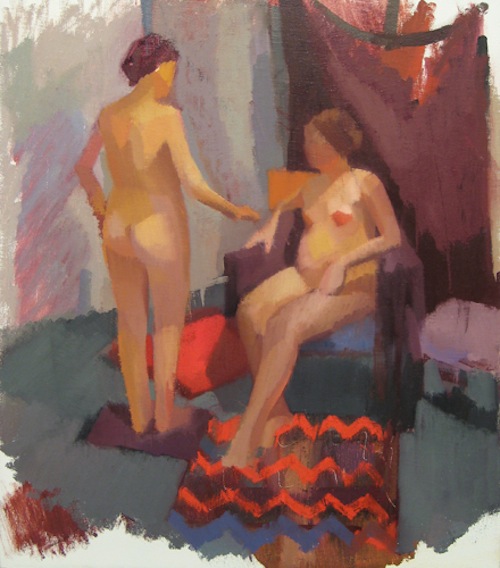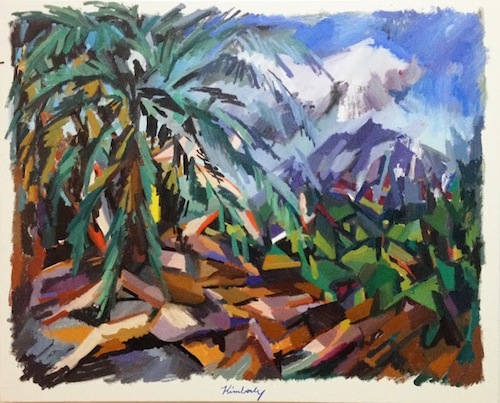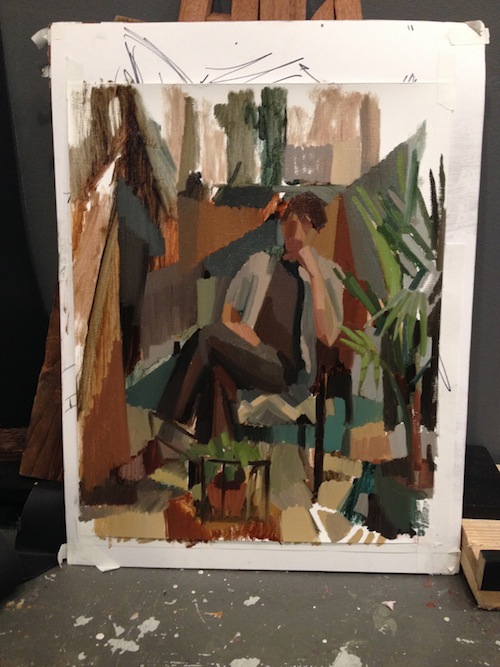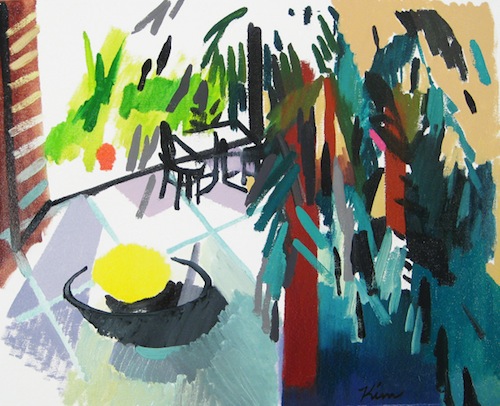Visual Arts Jake Uitti, Kim Trowbridge — February 11, 2014 11:22 — 0 Comments
The Artist Currently Known As Kim Trowbridge
Kim Trowbridge is a prolific painter who collaborates, teaches and travels – the woman seems to have a bottomless pit of energy! We talked with her about depression, working with a former Monarch editor and what inspires her work. Enjoy!
Jake Uitti: Kim, from all accounts you’ve been quite busy of late – what have you been up to?
Kim Trowbridge: This past September, my exhibition “Story Tell Her” opened at Blindfold Gallery. I took over the entire space and created a narrative installation that invited the viewer into my process of building a visual language. This show was massively important to me because it articulated my interest in narrative and my exploration of how paintings can be situated within a contemporary context.
A few days after the opening for “Story Tell Her,” I flew to Spain to teach my 10-day Plein Air Painting Tour with several of my private students. This was my second year doing this tour (this next year will be in Portugal!
After teaching, I took part in a month-long residency in Catalonia, at the foothills of the Montserrat Mountains, just north of Barcelona. This was a creative and spiritual awakening for me, after a year of struggling with some pretty serious depression. I painted outside each day in the mountains, and then combined these studies into larger paintings and collages in the studio at night.
Since returning from this residency I have been on fire creatively. I am working on a new body of work that is combining images from Catalonia with images from my immediate studio environment. I feel like this work is about me trying to carry-over this new vision of freedom and selfhood into my life at home. They feel challenging and celebratory. Working in the plein-air tradition has really inspired me to think about my surroundings in a different way – that everything and anything around me can make its way into the work. Here is the first painting I did when I got back to Seattle. It poured out of me fast and furious and in one shot.
And more images!
In a show that just recently came down, “Poetry // Painting” at Blindfold gallery, my dear friend Andrew Bartels (note: the poet and former Monarch editor) and I collaborated on a piece called “Documents.” This is an installation of images, texts, photographs… it was an incredibly meaningful experience for both of us.
Since returning from Catalonia, my heart is so big that I need a whole new vocabulary to write a love letter to the world. So, I am teaching myself piano. I’ve never played an instrument before. I am loving it! I am dreaming HUGE. I am thinking about painting, installation, writing songs, dancing, and about performance.Â
JU: You said you were struggling with depression this past year, can you explain what that was like and how you got through it, or, are getting through it?
KT: I’ve struggled with depression my entire life, off and on; it’s a deep river that runs through the women in my family. This past year was particularly difficult for me, for no apparent external reasons – in fact, only really wonderful things were happening – teaching was going well, lecturing was going well, my work was coming along in the studio, I had some time off to work on my upcoming show, and my Spain painting tour and residency were on the horizon… but something inside was kicking back against myself. I was unable to find meaning in anything. People assume that making art can pull you through that, and often it can, but when you hit a real low the act of creating – of making something out of nothing – is exactly what you cannot do.
My painting “Tantrum” finally did spill out of me, but it wasn’t easy and it took quite a bit out of me. In fact, I was pretty far along with another body of work that was suppose to be for my Blindfold show, but I had to completely abandon that work and face this other thing, this inner tantrum… The large wooden altarpiece and flanking “texts” were eventually necessary elements for me to be able to live with that image, to separate from it, to contextualize it so that I could move on and away from it. I was using a very historical format to deal with something utterly personal.
The culminating act of putting together my exhibition was a major step for me in my path towards coping. The whole second room of the installation was about rebuilding a language to write a new narrative after the fact of the tantrum. The dark cloud had necessarily passed, otherwise I could not’ve put the show together. But it still loomed there at the edge of my mind, and I was skeptical, cautious. My real healing process began during my time with my students in La Rioja painting outside each day, and then even more so on my own during my residency in Catalonia. It was incredibly meaningful for me to be out in nature, responding to light and trees and color, instead of inside myself in the studio, beating myself up over and over. Painting out in nature released me from my own content. It gave me the freedom to just respond, not to self-edit, to trust what I was observing out in the world. This experience, coupled with being around a wonderful small group of artists at Can Serrat was really magical for me. I felt like I was crawling out of a shell. I realized how isolated I’d been living, even convincing myself that isolation was what I most valued. I found incredible freedom and creativity in my new relationships. Collaboration became an exciting possibility in my mind…. and that’s a huge part of why I’m learning piano – I want to write songs with people.
JU: What was it like working with Andrew – this was a correspondence collaboration, right? He in New York City and you here in Seattle?
KT: My collaboration with Andrew was indeed a correspondence – me in Seattle; him Brooklyn. He wrote me letters and sent me old photographs he had taken from the time when he lived here with me at Top Hat. Many of the photos are from a tea party he and I had together, pretty soon after we met, in the dappled light of the sloping birch trees in the front yard. We became friends with great ease and passion back then, sharing a love of language and the visual realm.
Our correspondence was very much in the form of text messages too, which became a vital visual element for me. I often think of the iPhone as an ancient Egyptian tablet, and the images and messages as potential codes for some greater possible meaning. Our collaboration was rich and intimate, both an intellectually and creatively. It was an opportunity for us to examine our relationship, to correspond about our correspondence, to see what some of the “documents” of our relationship looked like as a visual cluster.
JU: What inspired you to play piano, over, say, the flute or the guitar?
KT: The keyboard seemed a natural choice for me, it is a visual pattern of black and white and fingers making shapes, all spanned-out in front of me like my palette. Â My beautiful wooden plein-air painting box feels to me like a magical little music box.
JU: When you’re not working on creating art, what do you like to do? Where do you eat, shop? Do you like to see movies?
KT: I love reading. It might be my very favorite thing to do. It even competes with painting. I read novels and poetry and history and critical thought, usually all at the same time. I also love walking in nature. Trees are my favorite thing to look at. I recently saw “Her” with Andrew and Caleb, but I think that was the first movie I’ve seen in a theater in about 5 years! I eat at home for the most part, but love getting drinks and small bites at The Saint and Oddfellows. Or a slice at Big Marios. But my local place is Loretta’s, just down the hill in South Park…
JU: What moves you most about the Seattle art scene? What aspects do you wish you could change?
KT: I’ve come to love the art scene in Seattle more and more, not less and less. It’s a supportive community and it’s going through an exciting period of transformation— away from traditional galleries into venues that are more flexible and better suited for a generation of artists who’ve already had to take-on the challenge and responsibility of running their own business and building their own audience. That is just the fact of the time we are living in, and so people like Sharon Arnold of LxWxH, and Sierra Stinson of Vignettes, are really working hard at coming up with ways to collaborate with artists that make more sense in this changing landscape. I think it’s incredibly exciting. It is also very difficult to navigate financially. But these new forms will become the mainstream forms at some point. This change is necessary both for artists, and for communicating with developing audiences.  I applaud the entrepreneurial spirit of Seattle, and I am thankful to be a part of it.
The answer isn't poetry, but rather language
- Richard Kenney











